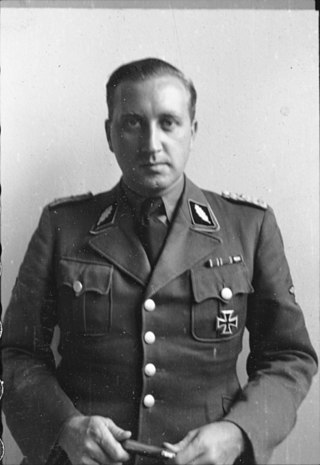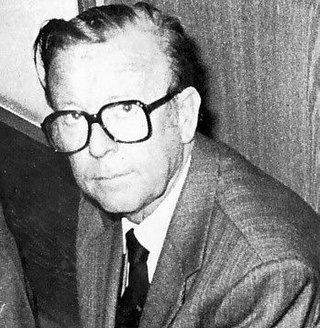
The Geheime Staatspolizei, abbreviated Gestapo, was the official secret police of Nazi Germany and in German-occupied Europe.
Sicherheitsdienst, full title Sicherheitsdienst des Reichsführers-SS, or SD, was the intelligence agency of the SS and the Nazi Party in Nazi Germany. Established in 1931, the SD was the first Nazi intelligence organization and the Gestapo was considered its sister organization through the integration of SS members and operational procedures. The SD was administered as an independent SS office between 1933 and 1939. That year, the SD was transferred over to the Reich Security Main Office, as one of its seven departments. Its first director, Reinhard Heydrich, intended for the SD to bring every single individual within the Third Reich's reach under "continuous supervision".

Alois Brunner was an Austrian officer who held the rank of SS-Hauptsturmführer (captain) during World War II. Brunner played a significant role in the implementation of the Holocaust through rounding up and deporting Jews in occupied Austria, Greece, France, and Slovakia. He was known as Final Solution architect Adolf Eichmann's right-hand man.

The Reich Security Main Office was an organization under Heinrich Himmler in his dual capacity as Chef der Deutschen Polizei and Reichsführer-SS, the head of the Nazi Party's Schutzstaffel (SS). The organization's stated duty was to fight all "enemies of the Reich" inside and outside the borders of Nazi Germany.

Serge Klarsfeld is a Romanian-born French activist and Nazi hunter known for documenting the Holocaust in order to establish the record and to enable the prosecution of war criminals. Since the 1960s, he has made notable efforts to commemorate the Jewish victims of German-occupied France and has been a supporter of Israel.

Helmut Herbert Christian Heinrich Knochen was the senior commander of the Sicherheitspolizei and Sicherheitsdienst in Paris during the Nazi occupation of France in World War II. He was sentenced to death first by a British military court in 1947, and then a French military court in 1954. After his sentences were commuted and reduced a few times, he was pardoned by President Charles de Gaulle and released in 1962.

Drancy internment camp was an assembly and detention camp for confining Jews who were later deported to the extermination camps during the German occupation of France during World War II. Originally conceived and built as a modernist urban community under the name La Cité de la Muette, it was located in Drancy, a northeastern suburb of Paris, France.

Beate Auguste Klarsfeld is a Franco-German journalist and Nazi hunter who, along with her French husband, Serge, became famous for their investigation and documentation of numerous Nazi war criminals, including Kurt Lischka, Alois Brunner, Klaus Barbie, Ernst Ehlers and Kurt Asche.

The Vel' d'Hiv' Roundup was a mass arrest of Jewish families in Paris on 16–17 July 1942 by French police and gendarmes at the behest of the German authorities. The roundup was one of several aimed at eradicating the Jewish population in France, in both the occupied zone and the free zone, that took place in 1942 as part of Opération Vent printanier. Planned by René Bousquet, Louis Darquier de Pellepoix, Theodor Dannecker and Helmut Knochen, it was the largest deportation of Jews from France.
The Sons and Daughters of Jewish Deportees from France is a French association of descendants of Jews deported from or displaced in France during the Nazi German occupation of France (1940–1944), during the Holocaust. Serge Klarsfeld—an academic historian specializing in the fate of Jews in France during World War II—founded the organization in 1979 and continues to serve as its president.
Rudolf Mildner was an Austrian-German SS-Standartenführer. He served as the chief of the Gestapo at Katowice and was the head of the political department at Auschwitz concentration camp, conducting "third degree" methods of interrogation from March 1941 until September 1943. As such, he frequently sent prisoners to Auschwitz for incarceration or execution. He visited Auschwitz on several occasions. In December 1944, he was appointed chief of the SiPo, Gestapo and SD in Vienna. After the war, Mildner testified at the Nuremberg Trials and remained in custody until 1949.

Ludwig Hermann Karl Hahn was a German SS-Standartenführer, Nazi official and convicted war criminal. He held numerous positions with the German police and security services over the course of his career with the Schutzstaffel (SS).
Helmut Hermann Wilhelm Bischoff was a German SS-Obersturmbannführer, Gestapo officer and Nazi government official. During World War II, he was the leader of Einsatzkommando 1/IV in Poland and later headed the Gestapo offices in Poznań (Posen) and Magdeburg.
Heinz Röthke was a German SS-Obersturmführer of Nazi Germany and a convicted war criminal. Röthke was the Gestapo Jewish expert in Paris, and, as such, was in overall charge of the concentration camp in Occupied France as well as of the deportation of Jews, between 1940 and 1944, during the Holocaust.
Heinrich Otto Seetzen, called Heinz Seetzen, was a German jurist, SS-Standartenführer and police colonel. Seetzen was a perpetrator of the Holocaust, responsible for the mass murder of civilians in Ukraine and in Belarus.

Herbert Martin Hagen was a German SS-Sturmbannführer of Nazi Germany and a convicted war criminal. Hagen served as personal assistant to the SS police chief in Paris Carl Oberg, heading the Gestapo department. Hagen was captured in 1945, but released in 1948. In 1955 he was sentenced to life imprisonment in absentia in France, after he was found guilty of being instrumental in the deportation of the Jews from France; nonetheless, he managed to avoid going to prison, and became a prominent West German industrialist. In 1980 after a change in the law to allow retrial of cases handled abroad, he was sentenced to 12 years in prison by a Cologne court, for his key role in the deportation of 73,000 Jews to the Auschwitz death camp. Hagen was released after serving only four years of prison, he died in Rüthen in 1999.
Ernst Misselwitz was an SS-Hauptscharführer who became head of the unit IV E of the RSHA – Reich Security Main Office of the Gestapo in occupied Paris, France, during World War II. In 1952 he was found guilty of having tortured French Resistance fighters. According to Serge Klarsfeld, French Intelligence employed Misselwitz after the war in helping them investigate Nazi war crimes and preparing court cases against wartime French collaborators.

Ernst Heinrichsohn was a German lawyer and member of the SS who participated in the deportation of French Jews to Auschwitz during World War II.
Carltheo Zeitschel also Carl Theo,, was a German physician, diplomat, Nazi functionary and SS-Sturmbannfuhrer (major).
Erich Isselhorst was a member of the Schutzstaffel (SS) member before and during World War II.











